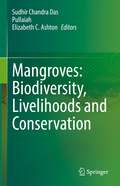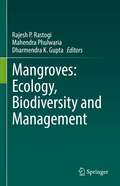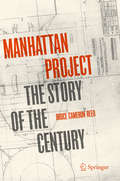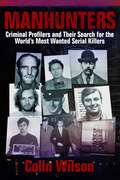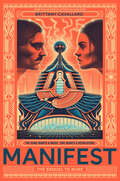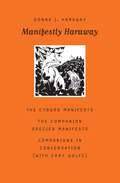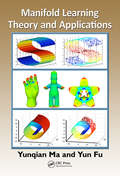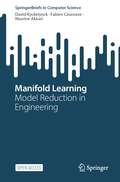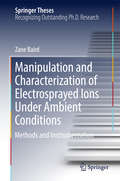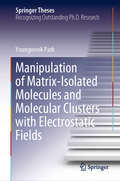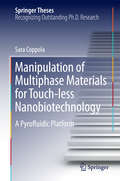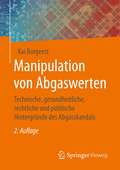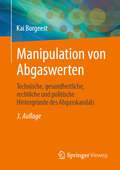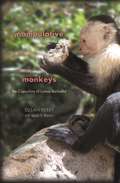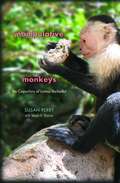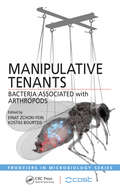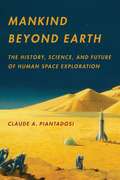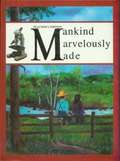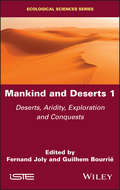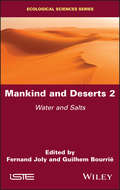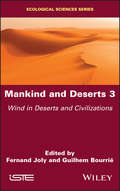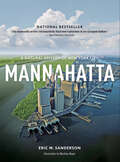- Table View
- List View
Mangroves: Biodiversity, Livelihoods and Conservation
by Sudhir Chandra Das Pullaiah Thammineni Elizabeth C. AshtonThis contributory volume is a comprehensive collection on the mangrove forest eco-system and its ecology, the resources and potentials of mangroves, conservation efforts, mangrove eco-system services and threats to conservation. The book is an all-inclusive compilation on the status, conservation and future of mangroves. Mangroves are a unique ecosystem providing several ecosystem services. They are formed in the inter-tidal areas of large rivers and coastal islands. Mangroves thrives due to constant interaction with the terrestrial and marine ecosystem. These are the species dynamics, varying tidal amplitudes, plant succession, changing floral pattern of the channels of the estuary, the varying sediment transportation. There was 20% decline in mangrove forest area in the last 25 years due mainly to conversion and coastal development. Lengthy recovery periods required for the degraded mangrove forests. Hence there is an urgent need to take stock of the updated information on these mangroves at global level. It is of immense value to scientific community involved in teaching, research and extension activities related to mangrove conservation.
Mangroves: Ecology, Biodiversity and Management
by Dharmendra K. Gupta Rajesh P. Rastogi Mahendra PhulwariaMangroves are one of the most productive and biologically important blue-carbon ecosystems across the coastal intertidal zone of earth. In the current scenario of serious environmental changes like global warming, climate change, extreme natural disasters, mangrove forests play a vital role in mitigating greenhouse gas emissions and maintaining ecosystem balance. Mangroves are unique ecosystems with rich biological diversity of different taxonomic groups exhibiting great ecological and commercial importance. The book consolidates existing and emerging information on ecology of mangroves, with a special reference to their biodiversity and management. It emphasizes on the role of mangroves in providing various ecological services. The book is a comprehensive compilation covering all aspects of mangrove ecology. It is useful for students and researchers in ecology, plants sciences and environmental sciences.
Manhattan Project to the Santa Fe Institute: The Memoirs of George A. Cowan
by George A. CowanThe telephone lay in pieces on George Cowan's office desk in the basement of Princeton's physics building. It was his first day as a graduate student in the fall of 1941. Down the hall, on the door of the cyclotron control room, a sign warned, Don't let Dick Feynman in. He takes tools. On that day, the future Nobel Prize winner Richard Feynman needed a piece from his new office mate's phone, so he borrowed it without even introducing himself.Cowan's memoir is an engaging eyewitness account of how science works and how scientists, as human beings, work as well. In discussing his career in nuclear physics from the 1940s into the 1980s, Cowan weaves in intriguing anecdotes about a large cast of distinguished scientists--all related in his wry, self-deprecating manner.Besides his nearly forty-year career at Los Alamos National Laboratory, Cowan also helped establish banks in Los Alamos and Santa Fe, served as treasurer of the group that created the Santa Fe Opera, and in the late 1980s participated in founding the Santa Fe Institute and served as its first president. He anchored its interdisciplinary work in his quest to find common ground between the relatively simple world of natural science and the daily, messy world of human affairs.Since the early 1990s Cowan has pursued a new interest in psychology and neuroscience to gain a deeper understanding of patterns of human behavior.This autobiography will appeal to anyone interested in a concise, intellectually engaged account of science and its place in society and public policy over the past seventy years.
Manhattan Project: The Story of the Century (Iop Concise Physics Ser.)
by Bruce Cameron ReedThough thousands of articles and books have been published on various aspects of the Manhattan Project, this book is the first comprehensive single-volume history prepared by a specialist for curious readers without a scientific background. This project, the United States Army’s program to develop and deploy atomic weapons in World War II, was a pivotal event in human history. The author presents a wide-ranging survey that not only tells the story of how the project was organized and carried out, but also introduces the leading personalities involved and features simplified but accurate descriptions of the underlying science and the engineering challenges. The technical points are illustrated by reader-friendly graphics. .
Manhunters: Criminal Profilers and Their Search for the World?s Most Wanted Serial Killers
by Colin WilsonAuthor Colin Wilson opens this illuminating psychological discussion with the development of the 1977 Behavioral Science Unit, which was set up in order to answer the many questions surrounding serial killers: How does someone become a serial killer? How do they choose their victims, and why do they not feel remorse? How are they caught? Wilson interviews FBI Special Agent Robert Ressler, coiner of the term "serial killer" and one of the pioneers of criminal profiling, as well as Ted Bundy and Charles Manson in order to figure out the motives behind their grisly actions.In Manhunters, by tracking the BSU's development of psychological profiling and genetic fingerprinting, Wilson reveals the forensic investigations that caused the seizure and arrest of some of the most vile and villainous people in the world, including Jeffrey Dahmer, William Heirens, Peter Sutcliffe, John Duffy, Jerry Brudos, Wayne Williams, and many more. As he divulges the details of each case, the murderers' fantasy worlds, sadistic motives, and monstrous psychological tendencies emerge.
Manifest
by Brittany CavallaroNew York Times bestselling author Brittany Cavallaro delivers the thrilling conclusion to her YA duology set in a reimagined American monarchy about a girl fighting for her own freedom, trying to change the government from within . . . or burn it all down.For the first time in her life, Claire Emerson isn’t under a man’s control. She’s escaped from her dangerous father, and her fiancé, Governor Remy Duchamp, is too weak to rule. All eyes fall on Claire—and the power she could wield.But that power is precarious as she and Remy are leading St. Cloud in exile after the General’s attempted coup. And when King Washington descends on the small province, he brings with him his baseball team, Claire’s brother, and a proximity to power Claire has never dreamed of. With few allies to support her, she determines her best chance at survival is earning the King’s good graces. Claire’s schemes quickly get out of hand, reminding her that it isn’t about who holds the power. It’s about a system that grants such power to a select few, and the men who built it that way. Claire isn’t anyone’s muse, and if she can’t fix the system from within, she’s determined to be the spark of revolution in the First American Kingdom.
Manifestly Haraway (Posthumanities #37)
by Donna J. HarawayElectrifying, provocative, and controversial when first published thirty years ago, Donna Haraway&’s &“Cyborg Manifesto&” is even more relevant today, when the divisions that she so eloquently challenges—of human and machine but also of gender, class, race, ethnicity, sexuality, and location—are increasingly complex. The subsequent &“Companion Species Manifesto,&” which further questions the human–nonhuman disjunction, is no less urgently needed in our time of environmental crisis and profound polarization.Manifestly Haraway brings together these momentous manifestos to expose the continuity and ramifying force of Haraway&’s thought, whose significance emerges with engaging immediacy in a sustained conversation between the author and her long-term friend and colleague Cary Wolfe. Reading cyborgs and companion species through and with each other, Haraway and Wolfe join in a wide-ranging exchange on the history and meaning of the manifestos in the context of biopolitics, feminism, Marxism, human–nonhuman relationships, making kin, literary tropes, material semiotics, the negative way of knowing, secular Catholicism, and more.The conversation ends by revealing the early stages of Haraway&’s &“Chthulucene Manifesto,&” in tension with the teleologies of the doleful Anthropocene and the exterminationist Capitalocene. Deeply dedicated to a diverse and robust earthly flourishing, Manifestly Haraway promises to reignite needed discussion in and out of the academy about biologies, technologies, histories, and still possible futures.
Manifold Learning Theory and Applications
by Yunqian Ma Yun FuTrained to extract actionable information from large volumes of high-dimensional data, engineers and scientists often have trouble isolating meaningful low-dimensional structures hidden in their high-dimensional observations. Manifold learning, a groundbreaking technique designed to tackle these issues of dimensionality reduction, finds widespread
Manifold Learning: Model Reduction in Engineering (SpringerBriefs in Computer Science)
by David Ryckelynck Fabien Casenave Nissrine AkkariThis Open Access book reviews recent theoretical and numerical developments in nonlinear model order reduction in continuum mechanics, being addressed to Master and PhD students, as well as to researchers, lecturers and instructors. The aim of the authors is to provide tools for a better understanding and implement reduced order models by using: physics-based models, synthetic data forecast by these models, experimental data and deep learning algorithms. The book involves a survey of key methods of model order reduction applied to model-based engineering and digital twining, by learning linear or nonlinear latent spaces.Projection-based reduced order models are the projection of mechanical equations on a latent space that have been learnt from both synthetic data and experimental data. Various descriptions and representations of structured data for model reduction are presented in the applications and survey chapters. Image-based digital twins are developed in a reduced setting. Reduced order models of as-manufactured components predict the mechanical effects of shape variations. A similar workflow is extended to multiphysics or coupled problems, with high dimensional input fields. Practical techniques are proposed for data augmentation and also for hyper-reduction, which is a key point to speed up projection-based model order reduction of finite element models.The book gives access to python libraries available on gitlab.com, which have been developed as part of the research program [FUI-25] MORDICUS funded by the French government. Similarly to deep learning for computer vision, deep learning for model order reduction circumvents the need to design parametric problems prior reducing models. Such an approach is highly relevant for image-base modelling or multiphysics modelling.
Manipulation and Characterization of Electrosprayed Ions Under Ambient Conditions
by Zane BairdThis thesis addresses the evolving field of measurement science, specifically that of mass spectrometry (MS) and ion mobility spectrometry (IMS) based techniques. It focuses on the design, construction and implementation of low-cost, easy-to-manufacture measurement tools that are used in modern settings such as airport security screening. Advances in these technologies often involve minimal performance enhancement at ever-increasing cost, which in turn limits accessibility to versatile measurement tools. This problem is addressed using hobbyest 3D printers along with widely available materials for the production of novel ion lenses and an IMS instrument with a performance comparable to that of many commercial systems. Baird#65533;s findings are of relevance to analytical chemistry and a source of inspiration for scientists exploring this emerging field.
Manipulation of Matrix-Isolated Molecules and Molecular Clusters with Electrostatic Fields (Springer Theses)
by Youngwook ParkThis book describes the manipulation of molecular properties, such as orientation, structure, and dynamics, of small molecules and molecular clusters isolated in cold inert matrices by using unprecedentedly strong external electrostatic fields. Manipulation of molecules with controllable external forces is a dream of chemists. Molecules are inherently quantum-mechanical systems, control of which potentially can lead to quantum technology, such as quantum sensing and computing. This book demonstrates a combination of the ice film nanocapacitor method and the matrix isolation technique enabled the application of intense external dc electric fields across the isolated molecules and molecular clusters. Changes in molecular states induced by fields were monitored by means of vibrational spectroscopy. Also, the book presents manipulations of the inversion tunneling dynamics of ammonia molecule and the dislocation of acidic proton in hydrogen chloride–water complex. The book shows that the vibrational spectroscopy with the aid of unprecedentedly strong dc electric field can provide rich information on the electrostatic behaviors of molecules and molecular clusters, which underlie the understanding of intermolecular processes and molecular manipulation.
Manipulation of Multiphase Materials for Touch-less Nanobiotechnology
by Sara CoppolaThe thesis presents an original and smart way to manipulate liquid and polymeric materials using a "pyro-fluidic platform" which exploits the pyro-electric effect activated onto a ferroelectric crystal. It describes a great variety of functionalities of the pyro-electrohydrodynamic platform, such as droplet self-assembling and dispensing, for manipulating multiphase liquids at the micro- and nanoscale. The thesis demonstrates the feasibility of non-contact self-assembling of liquids in plane (1D) using a micro engineered crystal, improving the dispensing capability and the smart transfer of material between two different planes (2D) and controlling and fabricating three-dimensional structures (3D). The thesis present the fabrication of highly integrated and automated 'lab-on-a-chip' systems based on microfluidics. The pyro-platform presented herein offers the great advantage of enabling the actuation of liquids in contact with a polar dielectric crystal through an electrode-less configuration. The simplicity and flexibility of the method for fabricating 3D polymer microstructures shows the great potential of the pyro-platform functionalities, exploitable in many fields, from optics to biosensing. In particular, this thesis reports the fabrication of optically active elements, such as nanodroplets, microlenses and microstructures, which have many potential applications in photonics. The capability for manipulating the samples of interest in a touch-less modality is very attractive for biological and chemical assays. Besides controlling cell growth and fate, smart micro-elements could deliver optical stimuli from and to cells monitoring their growth in real time, opening interesting perspectives for the realization of optically active scaffolds made of nanoengineered functional elements, thus paving the way to fascinating Optogenesis Studies.
Manipulation of the Avian Genome
by Robert J. Etches Ann M. GibbinsMany genes have been cloned from chicken cells, and during the next decade numerous laboratories will be concentrating their resources in developing ways of using these tools. Manipulation of the Avian Genome contains the most recent information from leading research laboratories in the areas of developmental and molecular genetics of the chicken. This information was presented at the Keystone Symposium held at Lake Tahoe in March, 1991. The book discusses potential applications of emerging technology in basic science and poultry production. Various techniques for altering genomic DNA, such as microinjection, retroviral vectors, and lipofection are covered. Genome evaluation using DNA fingerprinting and conventional breeding techniques are presented.
Manipulation von Abgaswerten: Technische, gesundheitliche, rechtliche und politische Hintergründe des Abgasskandals
by Kai BorgeestDieses kleine Buch stellt Hintergründe zum Abgasskandal dar, z. B. welche Schadstoffe kritisch sind, wie Motorsteuergeräte, Abgasrückführung und Abgasnachbehandlung funktionieren, wie Manipulationen auf dem Prüfstand möglich sind, mit welchen Fahrzyklen getestet wird und in welchem rechtlichen und politischen Umfeld dies lange Zeit unbemerkt mit unterschiedlichen Konsequenzen in der EU und den USA geschehen konnte. Es werden Maßnahmen vorgestellt, mit denen Fahrzeuge auch real gesetzliche Grenzwerte einhalten können und wie Manipulationen zukünftig rechtlich und politisch verhindert werden können. Dem Leser werden durch Literaturhinweise zusätzliche Details erschlossen.
Manipulation von Abgaswerten: Technische, gesundheitliche, rechtliche und politische Hintergründe des Abgasskandals
by Kai BorgeestDieses kleine Buch stellt Hintergründe zum Abgasskandal dar, z. B. welche Schadstoffe kritisch sind, wie Motorsteuergeräte, Abgasrückführung und Abgasnachbehandlung funktionieren, wie Manipulationen auf dem Prüfstand möglich sind, mit welchen Fahrzyklen getestet wird und in welchem rechtlichen und politischen Umfeld dies lange Zeit unbemerkt mit unterschiedlichen Konsequenzen in der EU und den USA geschehen konnte. Es werden Maßnahmen vorgestellt, mit denen Fahrzeuge auch real gesetzliche Grenzwerte einhalten können und wie Manipulationen zukünftig rechtlich und politisch verhindert werden können. Dem Leser werden durch Literaturhinweise zusätzliche Details erschlossen.
Manipulative Monkeys: The Capuchins of Lomas Barbudal
by Susan Perry Joseph H MansonWith their tonsured heads, white faces, and striking cowls, the monkeys might vaguely resemble the Capuchin monks for whom they were named. How they act is something else entirely. They climb onto each other's shoulders four deep to frighten enemies. They test friendship by sticking their fingers up one another's noses. They often nurse--but sometimes kill--each other's offspring. They use sex as a means of communicating. And they negotiate a remarkably intricate network of alliances, simian politics, and social intrigue. Not monkish, perhaps, but as we see in this downright ethnographic account of the capuchins of Lomas Barbudal, their world is as complex, ritualistic, and structured as any society. Manipulative Monkeys takes us into a Costa Rican forest teeming with simian drama, where since 1990 primatologists Susan Perry and Joseph H. Manson have followed the lives of four generations of capuchins. What the authors describe is behavior as entertaining--and occasionally as alarming--as it is recognizable: the competition and cooperation, the jockeying for position and status, the peaceful years under an alpha male devolving into bloody chaos, and the complex traditions passed from one generation to the next. Interspersed with their observations of the monkeys' lives are the authors' colorful tales of the challenges of tropical fieldwork--a mixture so rich that by the book's end we know what it is to be a wild capuchin monkey or a field primatologist. And we are left with a clear sense of the importance of these endangered monkeys for understanding human behavioral evolution.
Manipulative Monkeys: The Capuchins of Lomas Barbudal
by Susan PerryThe authors describe is behavior as entertaining--and occasionally as alarming--as it is recognizable: the competition and cooperation, the jockeying for position and status, the peaceful years under an alpha male devolving into bloody chaos, and the complex traditions passed from one generation to the next. <P><P>Interspersed with their observations of the monkeys' lives are the authors' colorful tales of the challenges of tropical fieldwork--a mixture so rich that by the book's end we know what it is to be a wild capuchin monkey or a field primatologist.
Manipulative Tenants: Bacteria Associated with Arthropods (Frontiers in Microbiology)
by Einat Zchori-Fein Kostas BourtzisIn the English edition of his landmark book Endosymbiosis of Animals with Plant Microorganisms (1965), Professor Paul Buchner is probably the most prominent founder of systematic symbiosis research. Summarizing the most up-to-date information available on bacterial symbionts of arthropods, this text provides an overview of primary symbionts as well as the most abundant secondary symbionts known to date. To encourage the integration of theory and practice in efforts to find innovative routes to pest and disease management, the editors bring together entomologists and microbiologists to create a full picture of the complex systems. Including diagrams, tables, graphs, pictures, and chemical structures, the text offers comprehensive information and a unique perspective on a fast-growing field.
Mankind Beyond Earth
by Claude PiantadosiSeeking to reenergize Americans' passion for the space program, the value of the Moon, and the importance of people in the final frontier, Claude A. Piantadosi presents a rich history of American space exploration and its extraordinary achievements. He emphasizes the importance of continuing manned and unmanned space missions to American and human interests, and he stresses the many adventures that still await us in the unfolding universe. Remaining cognizant of space exploration's practical and financial obstacles, Piantadosi nevertheless challenges us to revitalize our leadership in space and reap its vast scientific bounty.Along with being a captivating story of ambition, invention, and discovery, Piantadosi's history explains why space exploration is increasingly difficult and why space experts always seem to disagree. He argues that the future of the space program requires merging the practicalities of exploration with the constraints of human biology. Space science deals with the unknown, and the margin (and budget) for error is small. Lethal near-vacuum conditions, deadly cosmic radiation, microgravity, vast distances, and highly scattered resources remain immense physical problems. To be competitive, America needs to develop affordable space transportation and flexible exploration strategies grounded in sound science. Piantadosi closes with suggestions for accomplishing these goals, combining his skepticism as a scientist with an unshakable belief in space's untapped-and wholly worthwhile-potential.
Mankind Beyond Earth: The History, Science, and Future of Human Space Exploration
by Claude PiantadosiSeeking to reenergize Americans' passion for the space program, the value of further exploration of the Moon, and the importance of human beings on the final frontier, Claude A. Piantadosi presents a rich history of American space exploration and its major achievements. He emphasizes the importance of reclaiming national command of our manned program and continuing our unmanned space missions, and he stresses the many adventures that still await us in the unfolding universe. Acknowledging space exploration's practical and financial obstacles, Piantadosi challenges us to revitalize American leadership in space exploration in order to reap its scientific bounty.Piantadosi explains why space exploration, a captivating story of ambition, invention, and discovery, is also increasingly difficult and why space experts always seem to disagree. He argues that the future of the space program requires merging the practicalities of exploration with the constraints of human biology. Space science deals with the unknown, and the margin (and budget) for error is small. Lethal near-vacuum conditions, deadly cosmic radiation, microgravity, vast distances, and highly scattered resources remain immense physical problems. To forge ahead, America needs to develop affordable space transportation and flexible exploration strategies based in sound science. Piantadosi closes with suggestions for accomplishing these goals, combining his healthy skepticism as a scientist with an unshakable belief in space's untapped—and wholly worthwhile—potential.
Mankind Marvelously Made (Schoolaid Health)
by SchoolaidThis book has been compiled by the combined efforts of the Schoolaid group which includes teachers and ex-teachers with years of teaching experience behind them. We gratefully acknowledge the various helps and reviewing of manuscripts by professionals and practitioners in the medical field. We are indebted to the references, too numerous to mention, which we researched for all facts and knowledge used herein. We are deeply grateful to the many writers who submitted articles and true stories for our use. As with all our other publications, we refrain to publish the names of either the editors or the numerous contributors, choosing to give all credits to God who made this work possible and to whom we dedicate it. Our prayer as we send this book forth to be used in our own schools is that it may bring honor to His name, and practical knowledge to our children.
Mankind and Deserts 1: Deserts, Aridity, Exploration and Conquests
by Guilhem Bourrié Fernand JolyThe wild beauty of deserts has always been a source of fascination the world over. Mankind and Deserts 1 – the first of three volumes – describes their location and geographic variety. There are both hot and cold deserts, those at high altitude or those at sea level, differing in climate but sharing the scarcity of water, extreme temperatures and often violent winds. According to paleoclimate evidence, however, deserts have not always been as arid as they are today. Deserts were a source of inspiration for many spiritual leaders, among them, Moses, Jesus and Muhammad; as well as conquerors, from Alexander the Great to Genghis Khan. Some avoided these deserts, or crossed them as fast as they could. Others adapted to them and developed vibrant civilizations and cities. From ancient, almost mythical, exploration to modern scientific studies, deserts have come to be better known yet still hold great appeal. This book traces the history of their knowledge while providing a basis for understanding their features and the tools needed for their protection, in an ever-changing world.
Mankind and Deserts 2: Water and Salts
by Guilhem Bourrié Fernand JolyThe wild beauty of deserts has always been a source of fascination the world over. Mankind and Deserts 2 – the second of three volumes – focuses on water, its absence or indeed its extreme scarcity, as well as on the ways in which salts come to be formed in areas such as these. Aridity of the climate does not exclude rainfall, after which deserts flourish; wet mists, dew, exceptional events separated by years of total drought. Water flows into temporary and disorganized networks but, occasionally, large rivers cross the deserts, giving rise to vibrant civilizations: the Nile, Tigris and Euphrates, Niger, to name a few. Temporary or permanent lakes collect water in basins without outlet to the ocean, referred to as endorrheic basins, such as Lake Chad. This results in salt accumulation and evaporitic formations. A large variety of salts crystallize, in addition to halite, among which is potash. Halite – common salt – is an essential resource and its trade leads to the creation of salt caravans, used to exchange it with gold, even on a 1-1 weight basis, generating subsequent wealth. From ancient, almost mythical, exploration to modern scientific studies, deserts have come to be better known yet still hold great appeal. This book traces the history of their knowledge while providing a basis for understanding their features and the tools needed for their protection, in an ever-changing world.
Mankind and Deserts 3: Wind in Deserts and Civilizations
by Guilhem Bourrié Fernand JolyThe wild beauty of deserts has always been a source of fascination the world over. Mankind and Deserts 3 – the third and final volume – focuses on wind, frequently present in all deserts, either hot or cold. Wind plays a major role in aridity and landscapes bear numerous forms due to its action, erosion, transportation and surface formations, some discreet and others spectacular, such as vast expanses of towering yardangs. Aeolian dynamics lead to dune formation, simple or associated with sand ridges or ergs, as in the Sahara. Mankind has attempted, to varying degrees of success, to cope with sand accumulation; ignoring aeolian dynamics has led many development projects to failure. This is developed by Yann Callot, a Professor at Lyon University who studied aeolian dynamics in the Sahara. Traditional societies have adapted to live in deserts, establishing vibrant civilizations with original ways of living, managing water resources and creating routes for trade, especially for salt. In a changing environment, useful lessons can be drawn from the genius of mankind's adaptation to such diverse and fragile environments. This is explained by Marc Côte, who was a Professor at Constantine (Algeria) and Aix-en-Provence Universities. From ancient, almost mythical, exploration to modern scientific studies, deserts have come to be better known yet still hold great appeal. This book traces the history of their knowledge while providing a basis for understanding their features and the tools needed for their protection, in an ever-changing world.
Mannahatta: A Natural History of New York City
by Eric W. SandersonWhat did New York look like four centuries ago? An extraordinary reconstruction of a wild island from the forests of Times Square to the wetlands downtown. Named a Best Book of the Year by Library Journal, New York Magazine, and San Francisco Chronicle On September 12, 1609, Henry Hudson first set foot on the land that would become Manhattan. Today, it&’s difficult to imagine what he saw, but for more than a decade, landscape ecologist Eric Sanderson has been working to do just that. Mannahatta: A Natural History of New York City is the astounding result of those efforts, reconstructing in words and images the wild island that millions now call home. By geographically matching an eighteenth-century map with one of the modern city, examining volumes of historic documents, and collecting and analyzing scientific data, Sanderson re-creates topography, flora, and fauna from a time when actual wolves prowled far beyond Wall Street and the degree of biological diversity rivaled that of our most famous national parks. His lively text guides you through this abundant landscape—while breathtaking illustrations transport you back in time. Mannahatta is a groundbreaking work that provides not only a window into the past, but also inspiration for the future. &“[A] wise and beautiful book, sure to enthrall anyone interested in NYC history.&” —Publishers Weekly (starred review) &“A cartographical detective tale . . . The fact-intense charts, maps and tables offered in abundance here are fascinating.&” —The New York Times &“[An] exuberantly written and beautifully illustrated exploration of pre-European Gotham.&” —San Francisco Chronicle &“You don&’t have to be a New Yorker to be enthralled.&” —Library Journal
